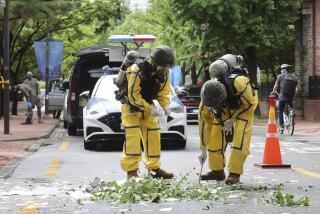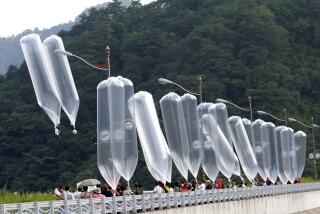A Hermit Kingdom cyber close-up
- Share via
I AM SOARING over North Korea, looking down on a denuded landscape and zooming in to hover over missile batteries, nuclear sites, huge palaces and prison camps. It’s a cyber tour, courtesy of Google Earth. I once visited North Korea as a reporter, yet this virtual view is far more revealing than anything I was permitted to see.
Has the Hermit Kingdom finally met its match? Software allowing users to cruise through satellite imagery of the world’s most secretive nation, cost-free at this beta moment, has attracted a talented crowd of photo reconnaissance buffs from around the world. They have dotted the patchwork of satellite photos with notes, helpfully identifying fascinating landmarks for e-gawkers like me. And they’re having a vigorous online debate over what some of the more mysterious looking items might be. (To join in, go to earth.google.com, download the program, click on Google Earth Community, then search for North Korea.)
An intrepid German poster named “wonders” has flagged more than 332 sites of interest. Most are military -- the vast air defenses ringing Pyongyang, the artillery along the demilitarized zone, the Yongbyon nuclear facilities, tunnels, caves and weird earthworks. He’s labeled a gigantic buried half-cylinder as “Underground parking garage -- not!” and an ominous-looking lump as a “Not too friendly looking thing.”
A more casual tourist can fly over Pyongyang and check out other sights, including the massive Kim Il Sung stadium, the Korean People’s Army Circus and the broad, traffic-free boulevards. Click on down into South Korea and the barren, deforested mountaintops give way to lush forests, the dusty valleys to emerald rice fields, the surface-to-air missiles to factories, houses and cars.
Of course we know the ugly facts about North Korea -- in the abstract: That it’s one of the poorest, most highly militarized nations in the world, with a malnourished population and a thirst for nukes. That it sends children of the disloyal to be worked to death in camps. That visible earthworks are most likely telltale signs of vast underground cities it has dug to hide its military facilities from Western spy satellites.
But we haven’t been able to see it for ourselves. Now Korean War veterans in Peoria or cyber geeks in Hong Kong can peer down upon the repressive state from their living rooms, for kicks.
Once the shock wears off, I wonder: Does this technology help North Korea more than it helps us? Some of the people who are posting on Google Earth say they have no doubt that “Dear Leader” Kim Jong Il -- who is known to be fascinated by the Internet -- is using the imagery for his own intelligence.
During the Cold War, North Korea, which doesn’t have its own satellites, surely got some intelligence on the South from the Soviets. Later we presumed it was buying it from commercial providers. Now, though, the Dear Leader can get it for free, just like the rest of us.
Of course, the quality won’t be as good as U.S. intelligence photos. There are no real-time images and no dates posted on Google Earth. We don’t know who the “analysts” are who are weighing in, unlike the occasional satellite photo posted on expert websites such as globalsecurity.org. And Google has said it doesn’t alter images, but some Google Earth content comes from governments that provide what they wish and from companies that may blur photos at their government’s request.
So, if what’s available online isn’t of high intelligence value, what about its propaganda value? Will the North Korean people compare their country with the outside world and revolt? In Jordan, the monarchy reportedly started blocking access to Google Earth after its subjects went online to check out the glitzy royal palaces. Kim has no such fears. Gordon Flake, a Google Earth aficionado and astute North Korea watcher at the Mansfield Foundation in Washington, estimates that only 1,000 of North Korea’s most trusted senior officials have unfettered Internet access.
Still, there is a major, unappreciated side effect to the freedom, openness and technological prowess showcased on sites such as Google Earth. It deprives the North Koreans of something they value above all: Face. Kim may rule in secret and hide nuclear secrets underground, but the shameful nature of his regime is on global display.
More to Read
Sign up for The Wild
We’ll help you find the best places to hike, bike and run, as well as the perfect silent spots for meditation and yoga.
You may occasionally receive promotional content from the Los Angeles Times.






